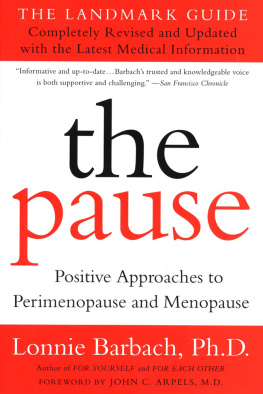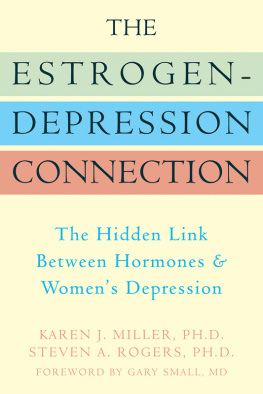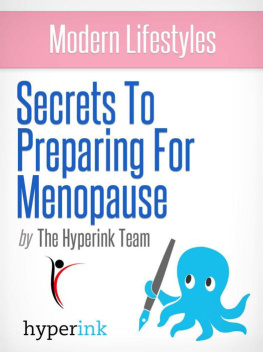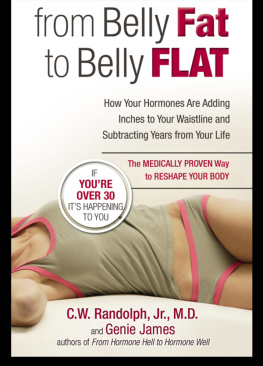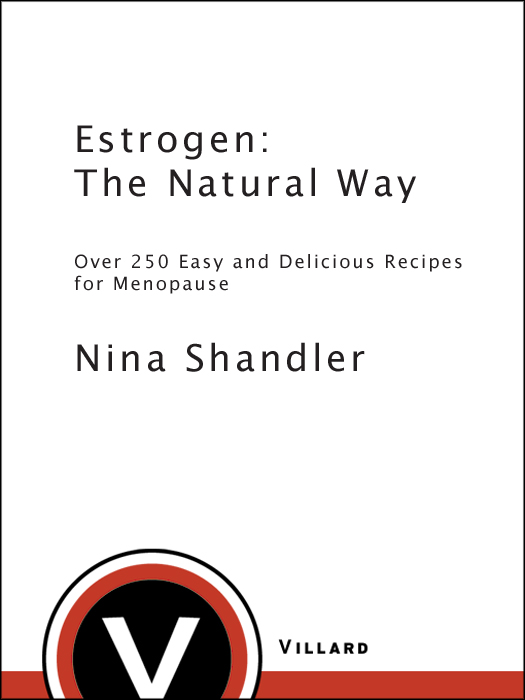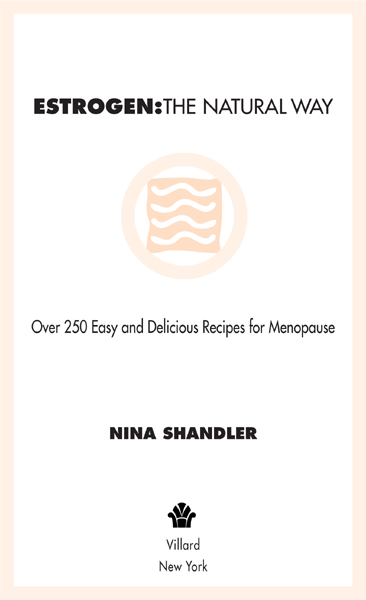Also by Nina Shandler
The Complete Guide and Cookbook for
Raising Your Child As a Vegetarian
Holiday Sweets Without Sugar
Homemade Mixes for Instant Meals the Natural Way
How to Make All the Meat You Eat Out of Wheat
Ways of Being Together: A Guide for Couples
Yoga for Pregnancy and Birth:
A Guide for Expectant Parents
The Marriage and Family Book
To the most thoroughly good people I know:
my mother, Mabel Silverberg, who has stayed sprightly
on a diet of kind thoughts,
and
my father, Carl Silverberg, who has nurtured
my confidence since the day I was born
Preface
Motivated by Menopause

During my first year of menopause, my life and my body changed.
Just as I was about to embark on my second adulthood, Manju, my older daughter, began her first. She graduated from Bennington College and moved to New York City. So, suddenly, she was no longer calling our house home. She was an artist, living on her own. As she prepared for her first show in the big city, she made a doll. Pleased with her production, she phoned me. Mom, I made this doll. Its sort of weird. Sort of creepy. Ugly. I love it.
I went to New York. I walked into Manjus apartment and entered her room. The doll sat in a corner. I sat down with the doll. I looked at her face. I could look at nothing else. Standing at the door of her room, Manju explained, Ive been thinking about making her for a long time. Shes a doll who got left in an attic. She grew old. She aged. Do you like her? I stared at this tiny vulnerable beingmy daughters creation. Her face was lined. Her forehead was furrowed. Her hair was thin. Her dress was faded. I touched her feet. Soft as a babys, yet they looked as if they had traveled through a century. I held her little, frail, withered hands. I felt as if she had received my touch, as though she were grateful for the acceptance. I said, Manju. Shes wonderful. Shes so wonderful. Manju told me, My roommates think shes scary. I said, Shes just old. I held the doll and felt as if I were holding myself. I realized, I have to nurture my own body the way I once nurtured my babies.
This book began as a personal project in my own menopausal self-care. My extreme hot flashes had convinced me I needed estrogen. When I couldnt tolerate hormone replacement pills, I investigated and discovered the existence of plant estrogens. I changed my diet. Along the way, I learned to love cooking for myself as much as I once loved making Mickey Mouse pancakes for my daughters, Manju and Sara.
One evening, my dear friend and neighbor Margaret stopped by. I was eating one of my new inventionsa chocolate pudding. Eat this, I insisted. She complied. She savored every bite. She offered her culinary critique: I love it. Then I broke the news: Its tofu. She said, Really! Give me the recipe.
My husband, Michael, looked up from reading Gail Sheehys New Passages and commented, You should write a book about plant estrogens. At that moment, this book was conceived.
To ensure that the book would be healthy, honest, and medically responsible, I enlisted the aid of three nutritionally oriented physicians. Their explanation of the well-researched estrogenic potential of food follows.
Next comes the story of my personal adventure in menopausal self-care, how I developed a workable, enjoyable dietary program for my own needs.
Before launching into recipes, I describe estrogen-rich plant foodswhat they are, where to find them, and how to use them.
Finally, I share more than 250 recipes, all tested in my own kitchen.
I truly hope this book helps you to nurture yourself safely through the second half of your life.
Acknowledgments

My list of people to thank begins with those who saw the possibilities for this project and nurtured it along the way:
Agnes Birnbaum, my agent, gave her all to this endeavor from the moment of our first conversation. She shepherded my proposal through the publishing world and shielded me from discouragement. At every turn, she cared for me as well as for my work.
Annik La Farge, my editor at Villard, saw the potential of this project and enabled me to tap it. She gave me the confidence to tell my story in my own voice, and she had the objectivity to tell me when that voice became breathless. She has been quick, smart, enthusiastic, and supportiveeverything an author could want from an editor.
Betsy Rapoport at Times Books was the first editor at Random House to see the proposal for this book. She passed it on to Annik, at Villard, but never abandoned it. She generously read the manuscript and gave valued suggestions.
Creating every book is a team effort. The entire Villard staff has rallied around this project. David Rosenthal, the publisher, lent his support throughout the entire process. Always pleasant and patient, Melissa Milsten steered it along the route from manuscript to finished book. Dan Rembert, the art director, Mary Ann Smith, the cover artist, and Debbie Glasserman designed an aesthetically appealing book from cover to cover. Sybil Pincus oversaw the production editing with respect for my meaning. Emily Pearl copyedited the manuscript with a meticulous eye for every important detail. Kirsten Raymond, my talented publicist, took on this project with unbounded enthusiasm, guiding and soothing me during my most fretful media moments. Im grateful to the entire energetic organization.
Michael Shandler, my husband, gave me the idea for this book. During its creation, he has tasted every recipe and read every line. In many ways this book is his babyhe conceived it and guided it through both the writing and the taste-testing process.
Barry Elson, M.D., Joyce Duncan, M.D., and Samuel Gladstone, M.D., accepted my proposal of partnership with enthusiasm. They gave this book credibility and contributed their expertise. Barrys extensive understanding of natural alternatives to hormone replacement therapy, Joyces knowledge of womens health issues, and Sams responsible questioning of evidence combined to create a careful and helpful analysis of the medical and nutritional value of plant estrogens. Perhaps best of all, we had fun. Our working relationships have been nothing but good.
Alicia Landman, M.D., provided thoughtful feedback on the first draft. Albey Reiner, Ph.D., helped me grapple with the projects feasibility.
In addition to these primary players, I also want to thank others. My wonderful children, Sara and Manju, deserve thanks for tolerating my estrogenic obsession. Jeff and Di Krauth, owners of Beyond Words Bookshop, made helpful title suggestions. My good friendsMargaret and Philip Gosselin, Martin and Melly Bock, Mary and Herb Bernstein, Joan and Rob Brandt, Laurie Pearlman, Ervin Staub, Ann Berliner, Vicky Elson, and Gavin Harrisonoffered encouragement and praised my recipes.
Contents



